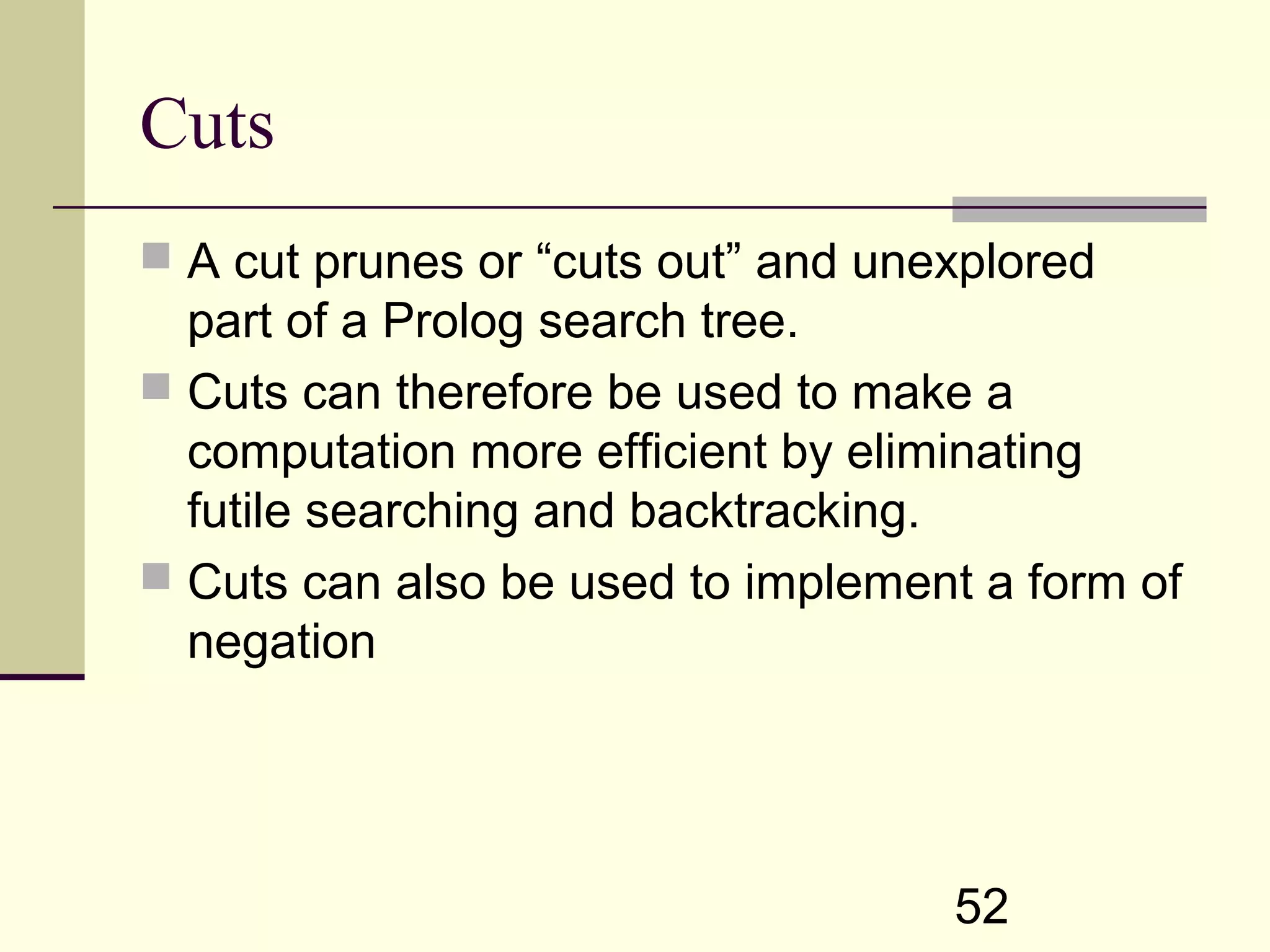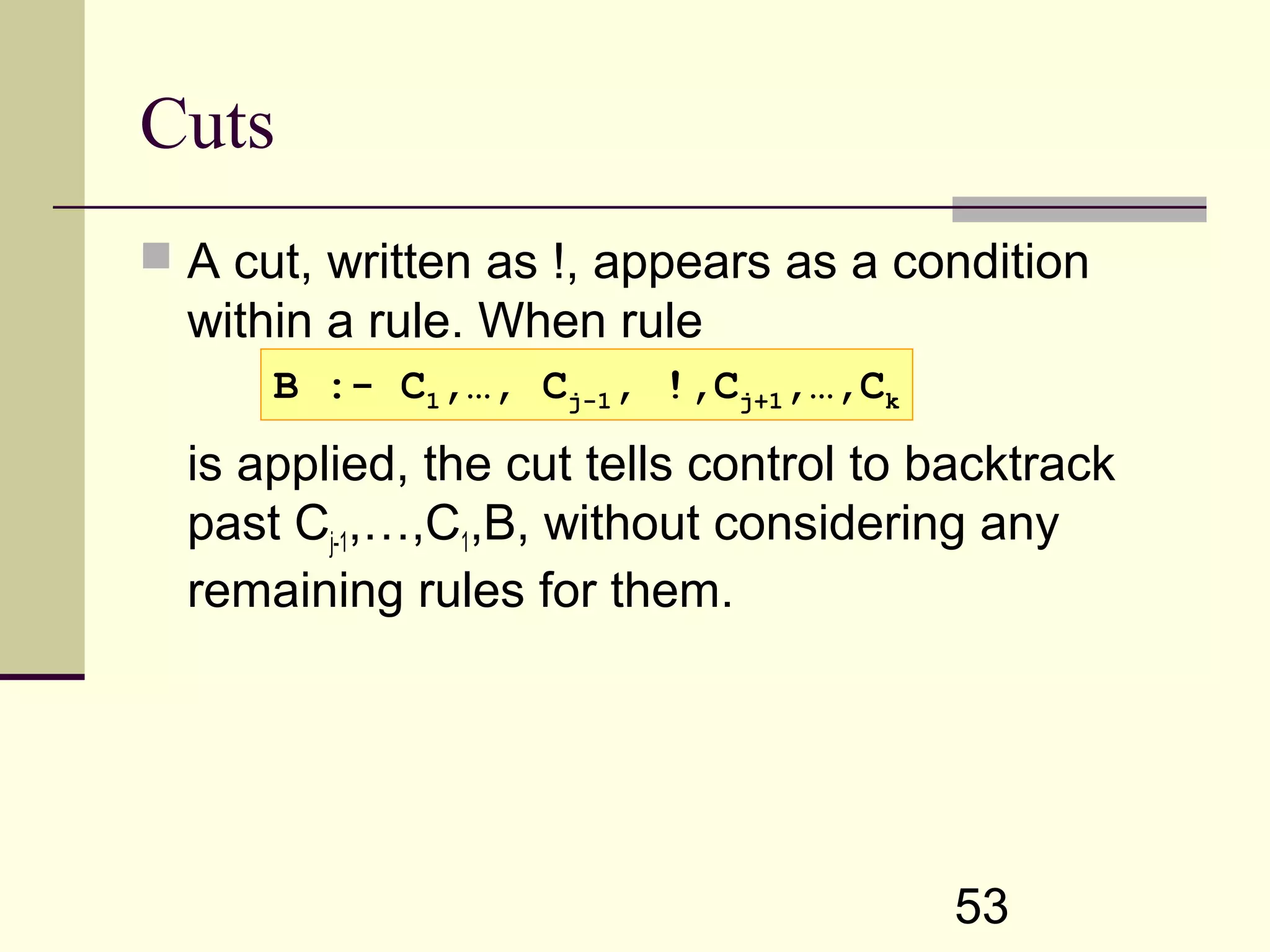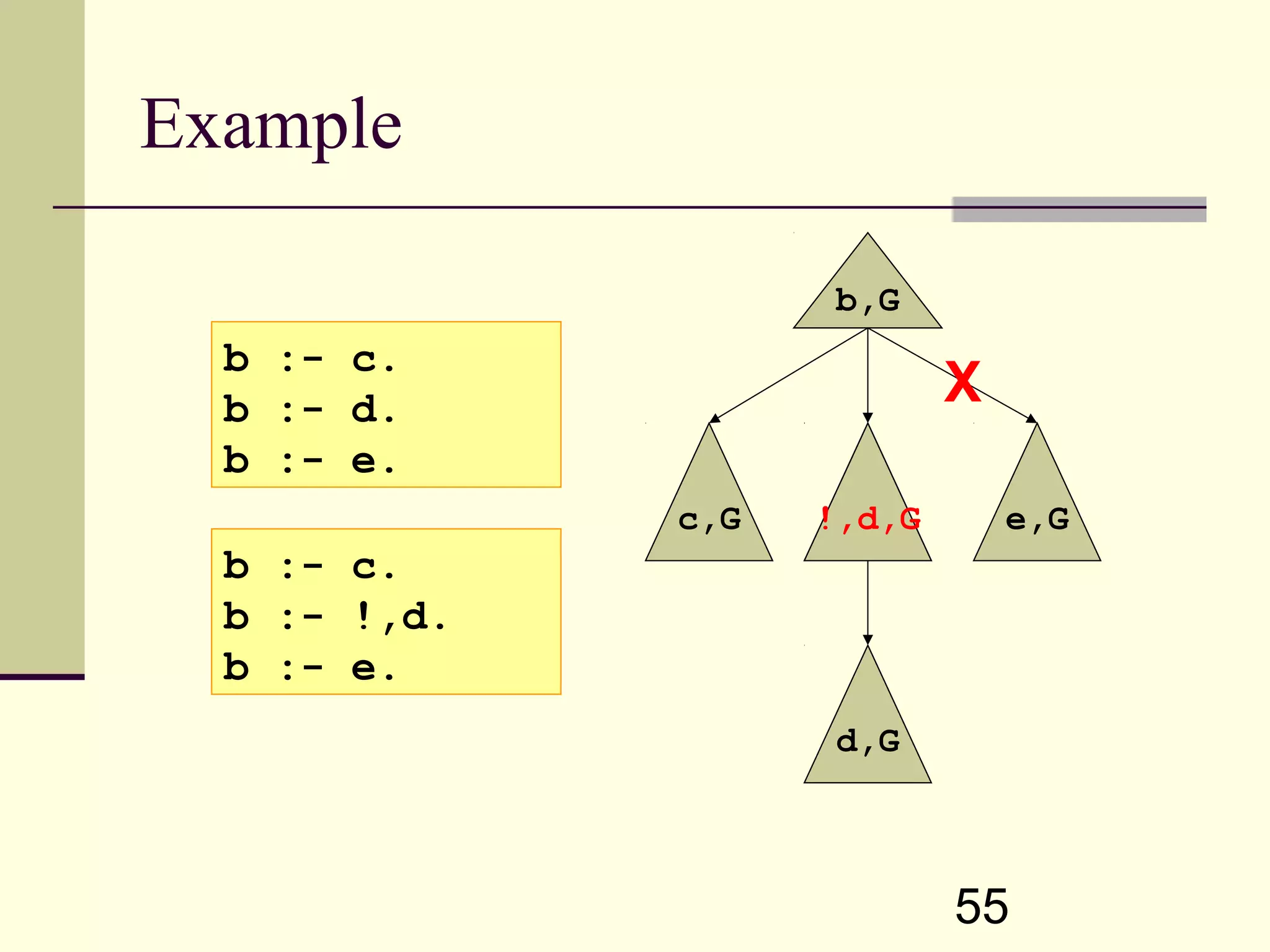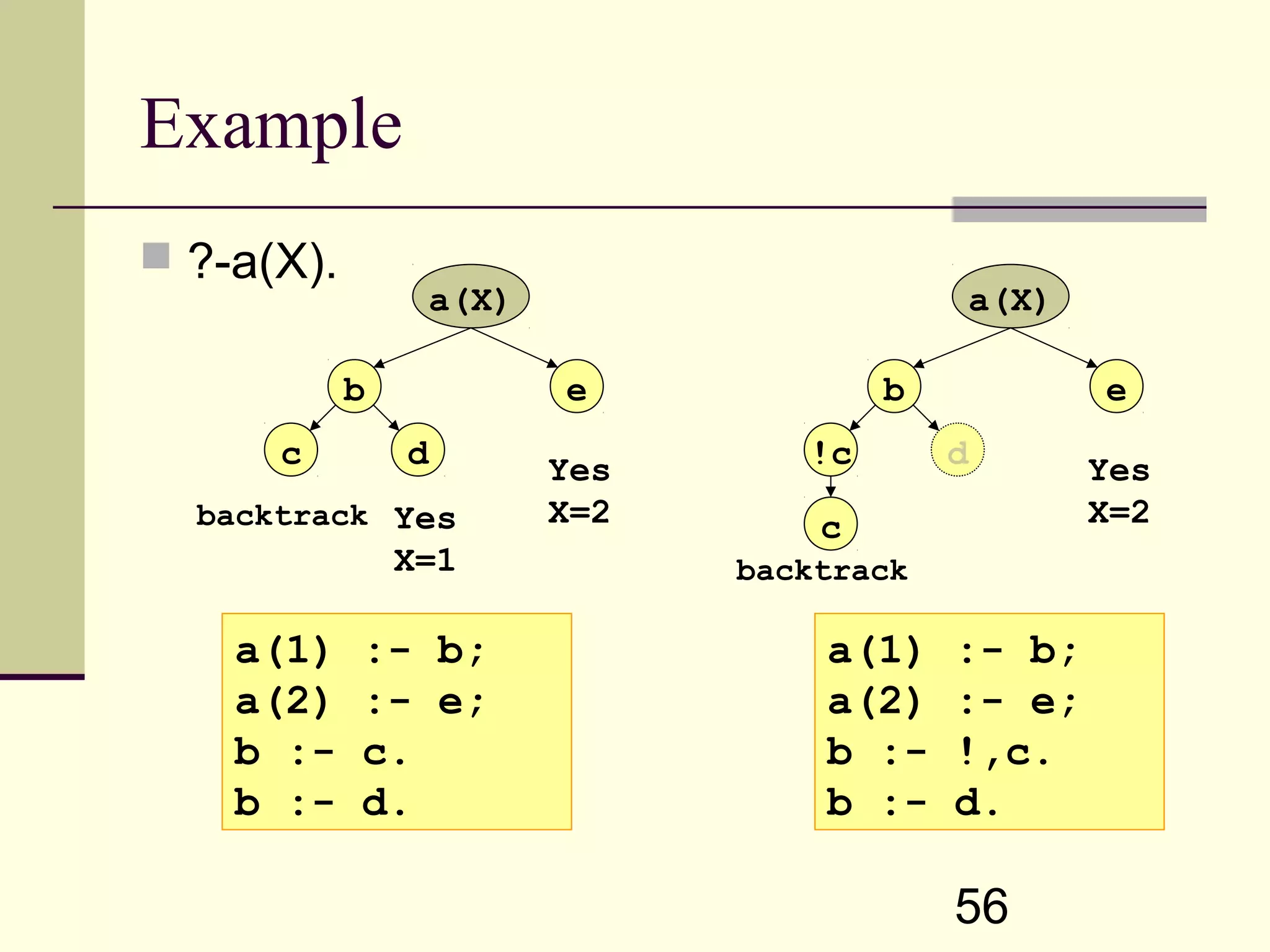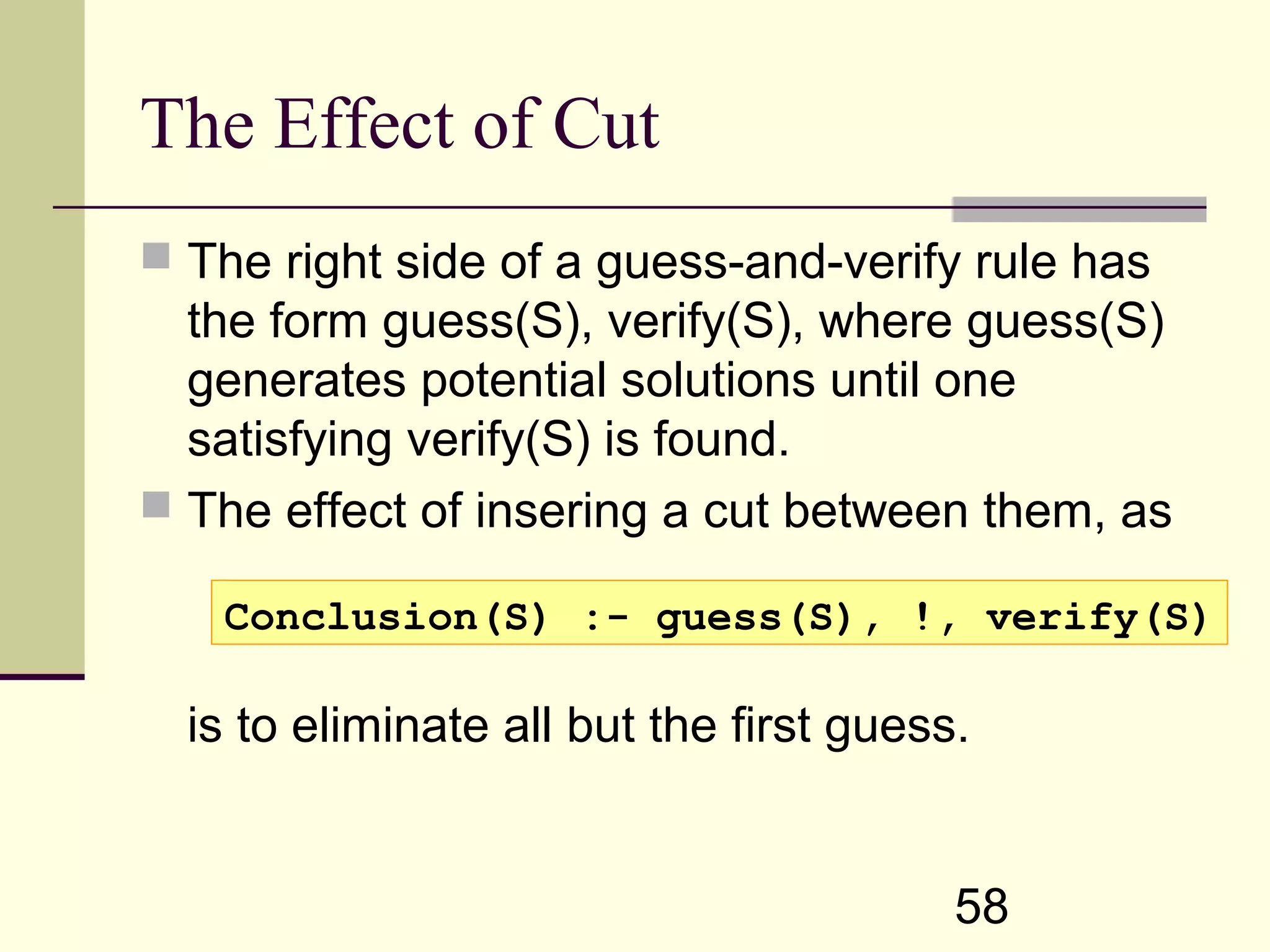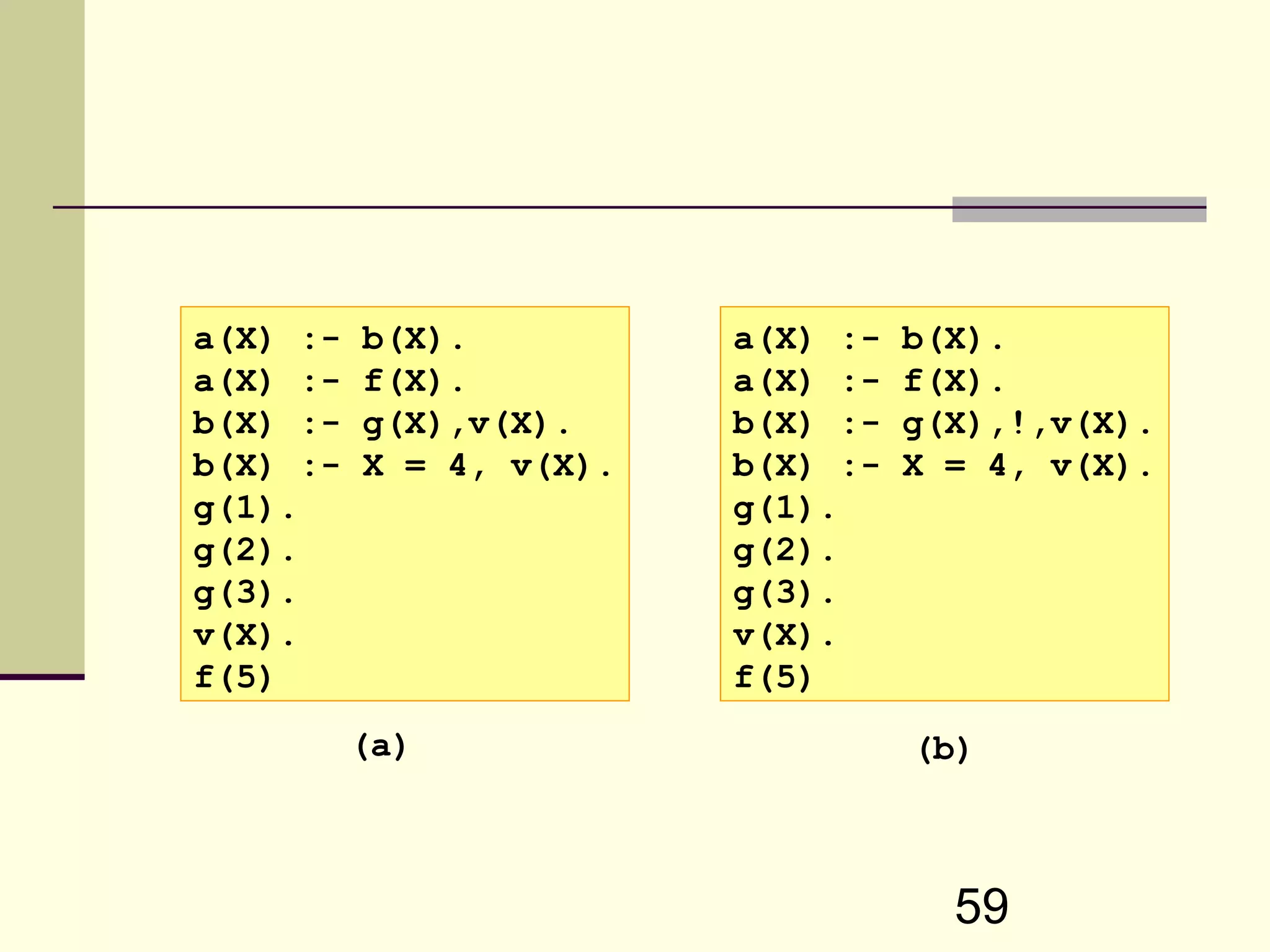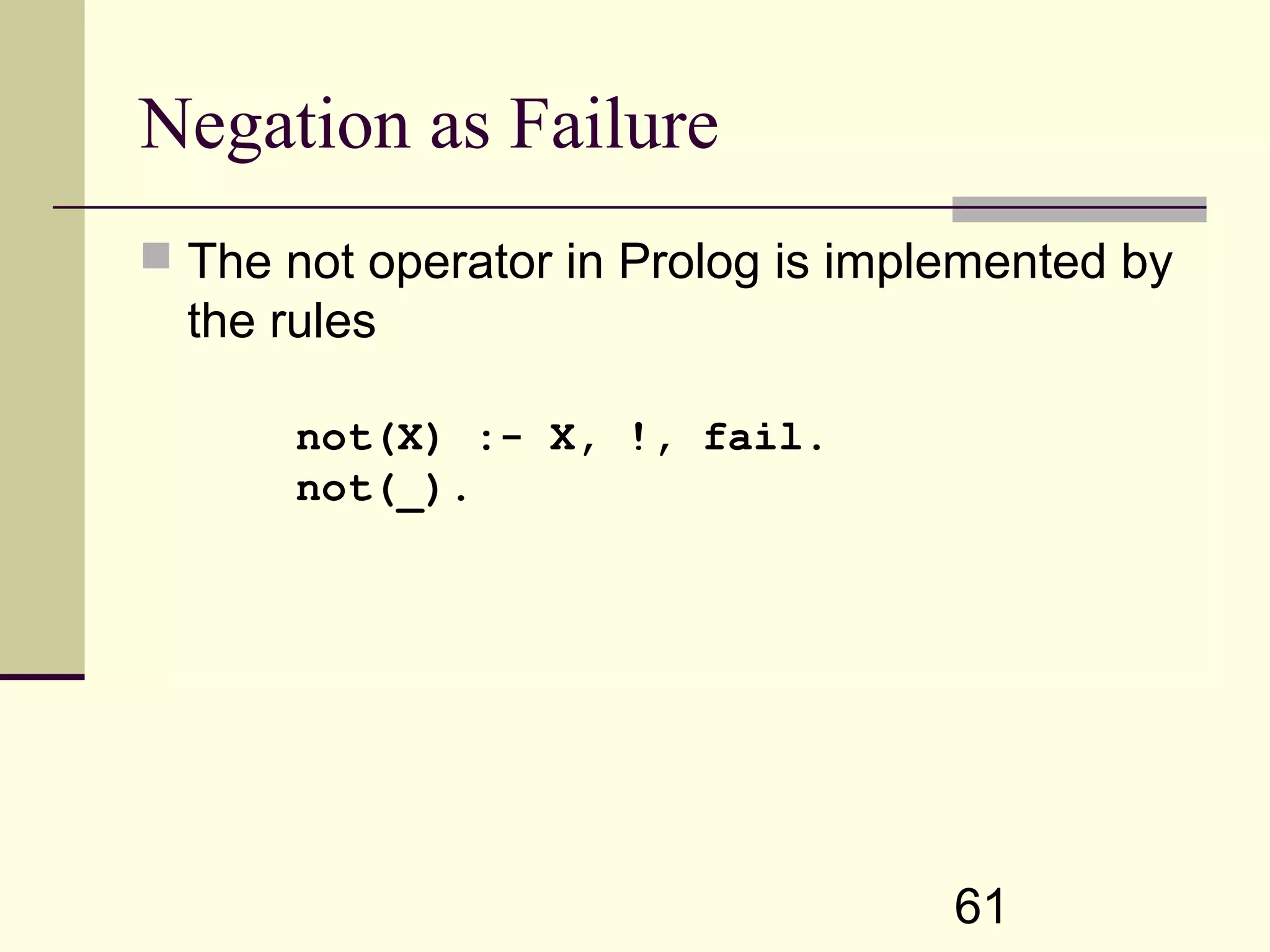This document discusses Prolog programming. It covers data structures in Prolog like lists and terms, programming techniques like guess-and-verify queries and open lists, and control in Prolog through goal ordering and rule selection. Lists can represent data structures and terms correspond to tree structures. Variables serve as placeholders and open lists allow modification of data. Control is characterized by selecting the leftmost goal and first applicable rule.

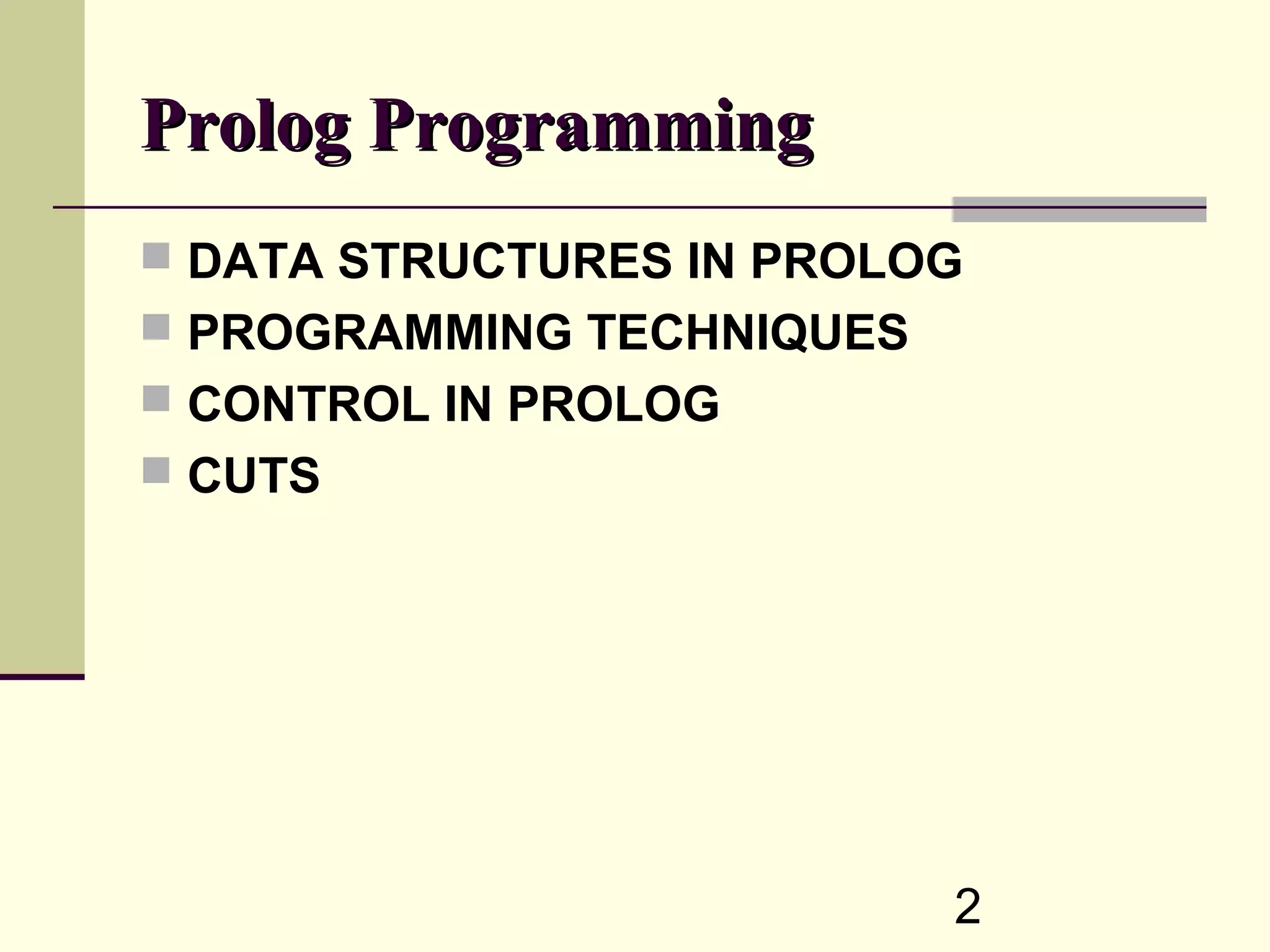

![4 Lists in Prolog The simplest way of writing a list is to enumerate its elements. The list consisting of the 3 atoms a, b and c can be written as [a, b, c] The list that doesn’t have elements called empty list denoted as [ ]](https://image.slidesharecdn.com/kcq6diylrzcefqezimhz-signature-a2aefd15529654f3e87e362a46d23579b835dc4f23157856393aba9ec132c113-poli-160425153457/75/Prolog-programming-4-2048.jpg)
![5 Lists in Prolog We can also specify an initial sequence of elements and a trailing list, separated by | The list [a, b, c] can also be written as [a, b, c | [ ] ] [a, b | [c] ] [a | [b, c] ]](https://image.slidesharecdn.com/kcq6diylrzcefqezimhz-signature-a2aefd15529654f3e87e362a46d23579b835dc4f23157856393aba9ec132c113-poli-160425153457/75/Prolog-programming-5-2048.jpg)
![6 Lists : Head & Tail A special case of this notation is a list with head H and tail T, written as [H|T] The head is the first element of a list, and The tail is the list consisting of the remaining elements. The list [a, b, c] can also be separated as • Head:The first element is a • Tail:The list of remaining elements = [b, c]](https://image.slidesharecdn.com/kcq6diylrzcefqezimhz-signature-a2aefd15529654f3e87e362a46d23579b835dc4f23157856393aba9ec132c113-poli-160425153457/75/Prolog-programming-6-2048.jpg)
![7 Lists : Unification Unification can be used to extract the components of a list, so explicit operators for extracting the head and tail are not needed. The solution of the query Bind variable H to the head and variable T to the tail of list [a, b, c]. ?- [H | T] = [a, b, c]. H = a T = [b, c]](https://image.slidesharecdn.com/kcq6diylrzcefqezimhz-signature-a2aefd15529654f3e87e362a46d23579b835dc4f23157856393aba9ec132c113-poli-160425153457/75/Prolog-programming-7-2048.jpg)
![8 Lists : Specified terms The query (partially specified terms) The term [ a | T ] is a partial specification of a list with head a and unknown tail denoted by variable T. Similarly, [ H, b, c] is a partial specification of a list with unknown head H and tail [b, c]. These two specification to unify H = a, T =[b,c] ?- [a | T] = [H, b, c]. T = [b, c] H = a](https://image.slidesharecdn.com/kcq6diylrzcefqezimhz-signature-a2aefd15529654f3e87e362a46d23579b835dc4f23157856393aba9ec132c113-poli-160425153457/75/Prolog-programming-8-2048.jpg)
![9 Lists in Prolog Example 2 The append relation on lists is defined by the following rules: Append([ ], Y, Y). Append([H | X], Y, [H | Z]) :- append(X,Y,Z). In words, The result of appending the empty list [ ] and a list Y is Y. If the result of appending X and Y is Z, then the result of appending [H | X] and Y is [H | Z]](https://image.slidesharecdn.com/kcq6diylrzcefqezimhz-signature-a2aefd15529654f3e87e362a46d23579b835dc4f23157856393aba9ec132c113-poli-160425153457/75/Prolog-programming-9-2048.jpg)
![10 Lists : Compute Arguments The rules for append can be used to compute any one of the arguments from the other two: Inconsistent arguments are rejected ?- append([a, b], [c, d], Z). Z = [a, b, c, d] ?- append([a, b], Y, [a, b, c, d]). Y = [c, d] ?- append(X, [c, d], [a, b, c, d]). X = [a, b] ?- append(X, [d, c], [a, b, c, d]). no](https://image.slidesharecdn.com/kcq6diylrzcefqezimhz-signature-a2aefd15529654f3e87e362a46d23579b835dc4f23157856393aba9ec132c113-poli-160425153457/75/Prolog-programming-10-2048.jpg)
![11 Terms as Data The Dot operator or functor ‘.’ corresponds to make list with H and T. [H | T ] is syntactic sugar for the term .(H,T) Lists are terms. The term for the list [a, b, c] is .(H,T) .(a, .(b, .(c, [])))](https://image.slidesharecdn.com/kcq6diylrzcefqezimhz-signature-a2aefd15529654f3e87e362a46d23579b835dc4f23157856393aba9ec132c113-poli-160425153457/75/Prolog-programming-11-2048.jpg)
![12 Terms as Data following terms can be drawn a tree There is a one-to-one correspondence between trees and terms .(a, .(b, .(c, []))) ∙ ∙ ∙ a b c []](https://image.slidesharecdn.com/kcq6diylrzcefqezimhz-signature-a2aefd15529654f3e87e362a46d23579b835dc4f23157856393aba9ec132c113-poli-160425153457/75/Prolog-programming-12-2048.jpg)
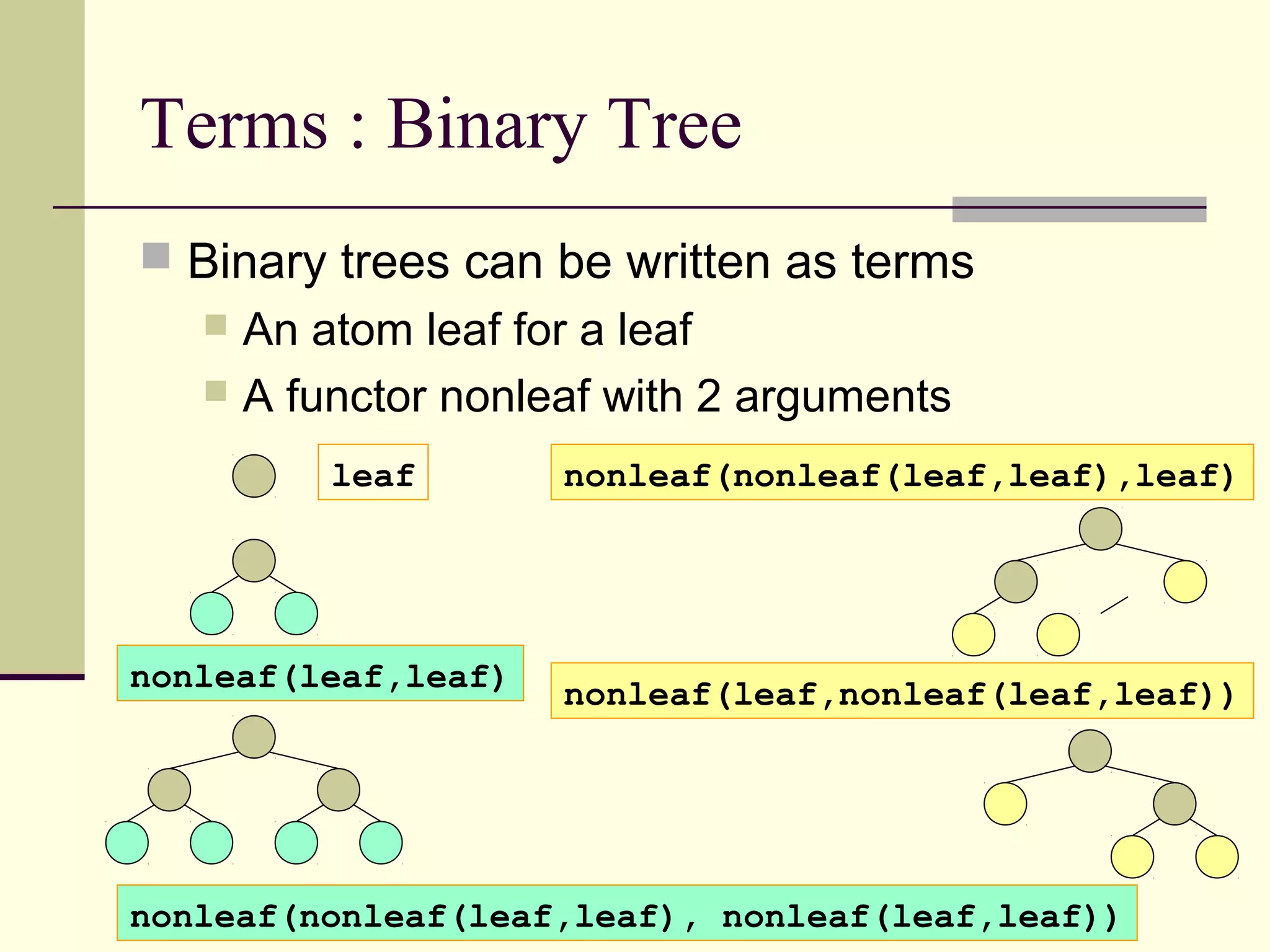
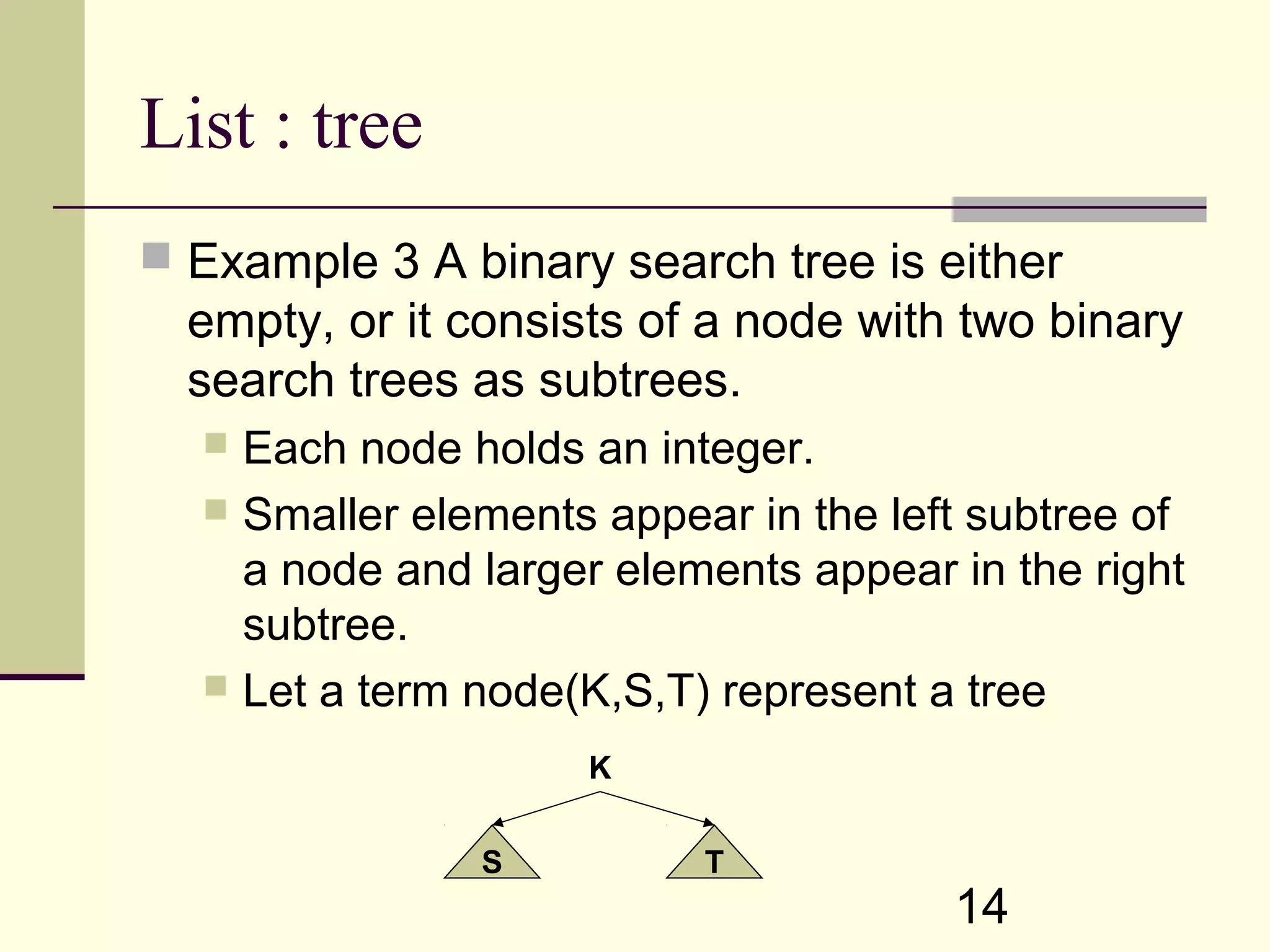
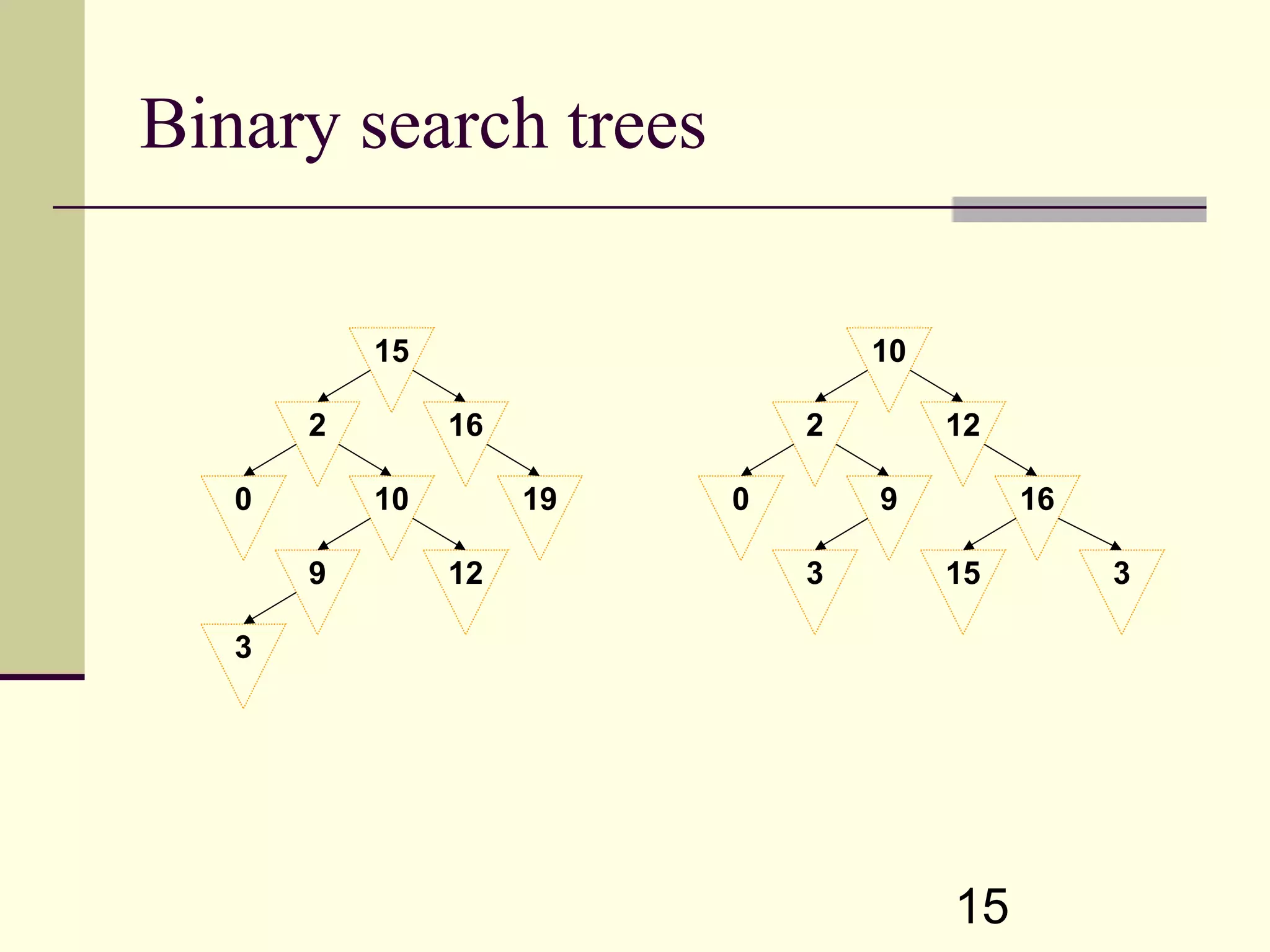

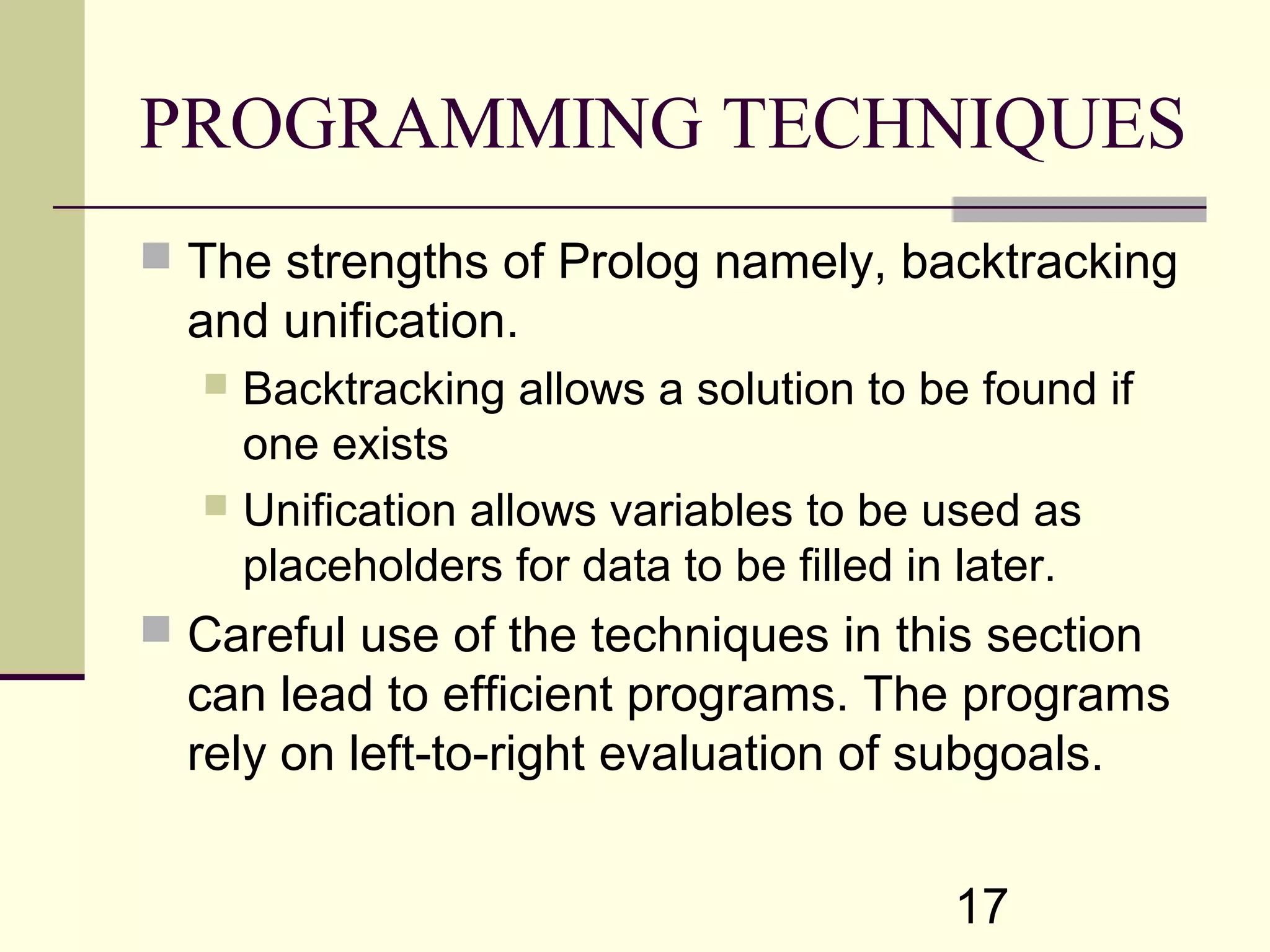
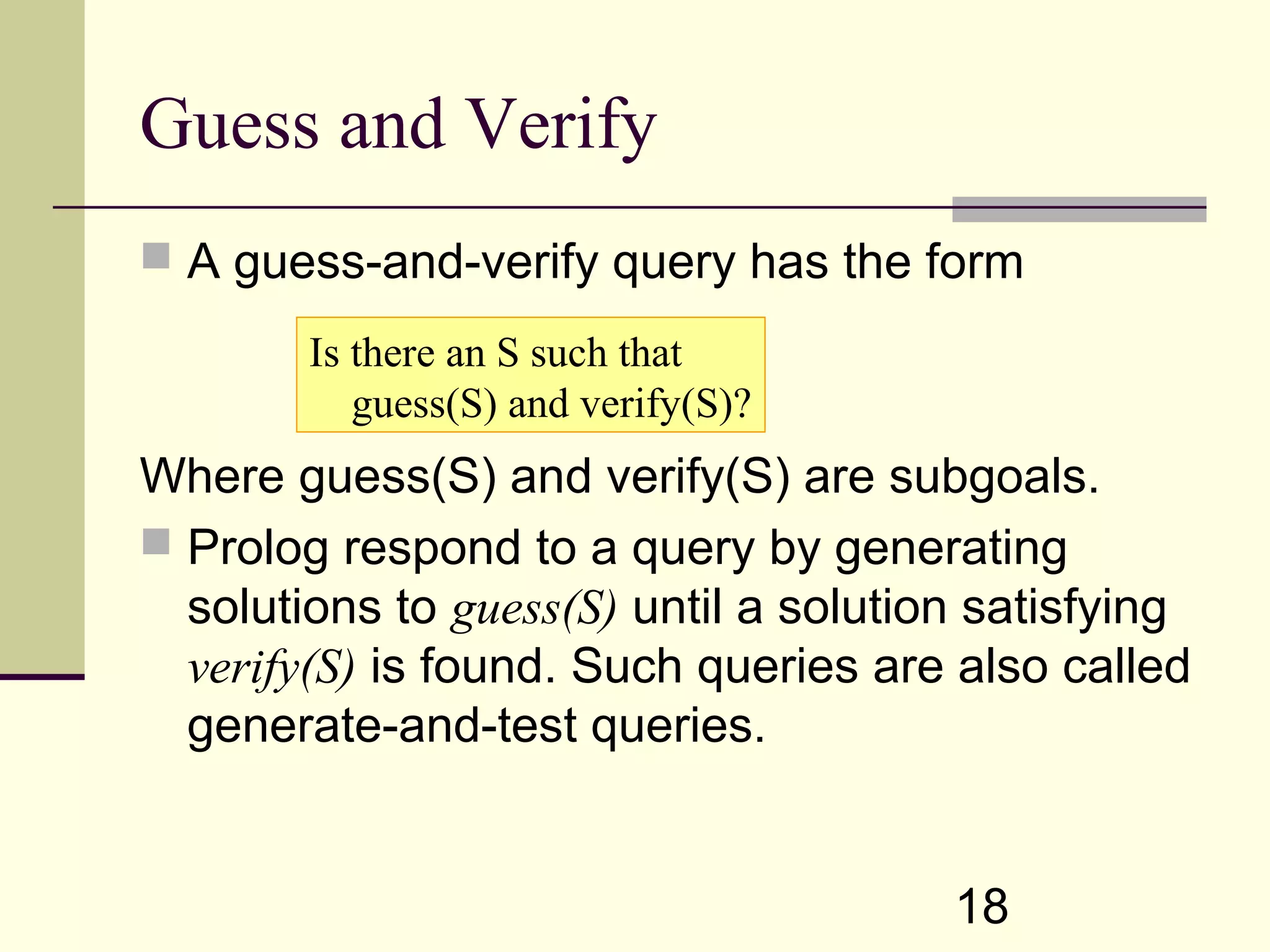
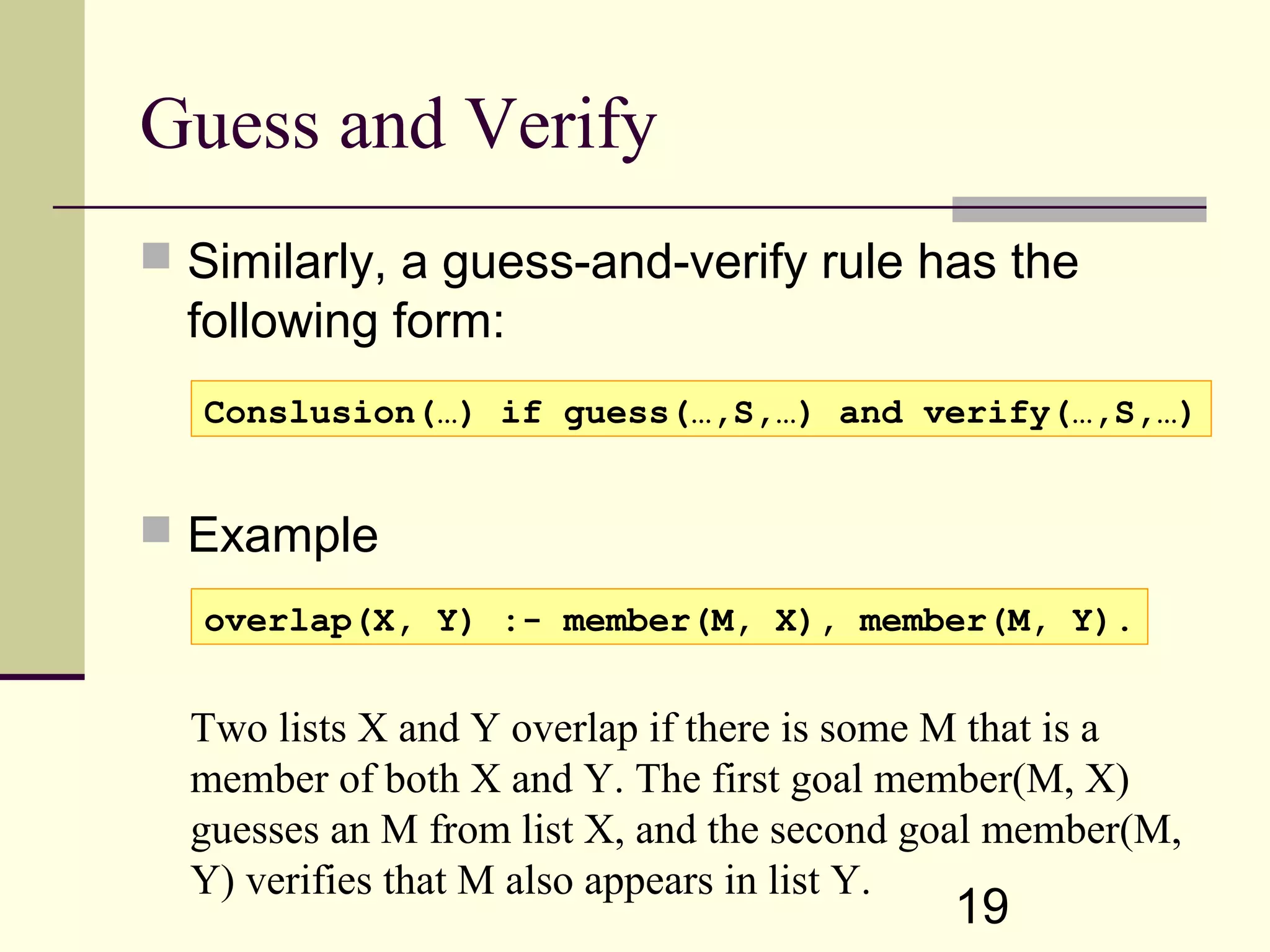
![20 The rules for member are member(M, [M |_]). Member(M, [_ |T]) :- member(M, T). The first rule says that M is a member of a list with head M. The second rule says that M is a member of a list if M is a member of its tail T.](https://image.slidesharecdn.com/kcq6diylrzcefqezimhz-signature-a2aefd15529654f3e87e362a46d23579b835dc4f23157856393aba9ec132c113-poli-160425153457/75/Prolog-programming-20-2048.jpg)
![21 Consider query These query The first goal in this query generates solutions and the second goal tests to see whether they are acceptable. ?- overlap([a,b,c,d],[1,2,c,d]). yes ?- member(M,[a,b,c,d]),member(M,[1,2,c,d]).](https://image.slidesharecdn.com/kcq6diylrzcefqezimhz-signature-a2aefd15529654f3e87e362a46d23579b835dc4f23157856393aba9ec132c113-poli-160425153457/75/Prolog-programming-21-2048.jpg)
![22 Consider query The solutions generated by the first goal are Test the second goal ?- member(M,[a,b,c,d]). M = a; M = b; M = c; M = d; no ?- member(a,[1,2,c,d]). no ?- member(b,[1,2,c,d]). no ?- member(c,[1,2,c,d]). yes](https://image.slidesharecdn.com/kcq6diylrzcefqezimhz-signature-a2aefd15529654f3e87e362a46d23579b835dc4f23157856393aba9ec132c113-poli-160425153457/75/Prolog-programming-22-2048.jpg)
![23 Hint Since computation in Prolog proceeds from left to right, the order of the subgoals in a guess-and-verify query can affect efficiency. Choose the subgoal with fewer solutions as the guess goal. Example of the effect of goal order ?- X = [1,2,3], member(a,X). no ?- member(a,X), X = [1,2,3]). [infinite computation]](https://image.slidesharecdn.com/kcq6diylrzcefqezimhz-signature-a2aefd15529654f3e87e362a46d23579b835dc4f23157856393aba9ec132c113-poli-160425153457/75/Prolog-programming-23-2048.jpg)

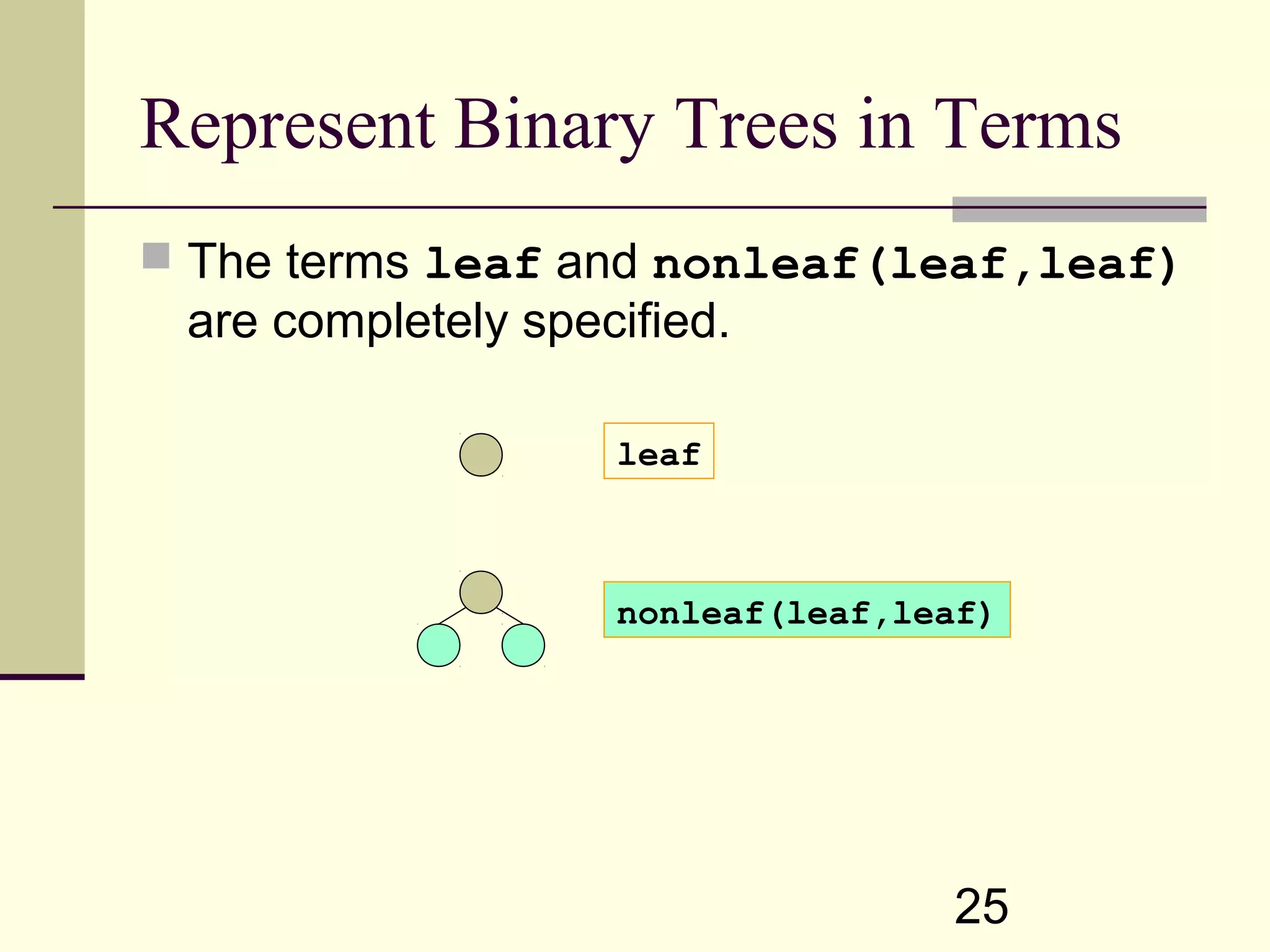
![26 Partially specified list The example list [a, b | X] has Its first element : a Its second element : b Do not yet know what X represents “Open list” if its ending in a variable, referred “end marker variable” “Close list” if it is not open.](https://image.slidesharecdn.com/kcq6diylrzcefqezimhz-signature-a2aefd15529654f3e87e362a46d23579b835dc4f23157856393aba9ec132c113-poli-160425153457/75/Prolog-programming-26-2048.jpg)
![27 How prolog know variable Prolog used machine-generated variables, written with a leading underscore (“_”) followed by an integer. ?- L = [a, b | X]. L = [a, |_G172] X = _G172 Yes](https://image.slidesharecdn.com/kcq6diylrzcefqezimhz-signature-a2aefd15529654f3e87e362a46d23579b835dc4f23157856393aba9ec132c113-poli-160425153457/75/Prolog-programming-27-2048.jpg)
![28 Prolog generates fresh variables each time it responds to a query or applies a rule. An open list can be modified by unifying its end marker ?- L = [a, b | X], X = [c,Y]. L = [a,b,c |_G236] X = [c,_G236] Y = _G236 Yes](https://image.slidesharecdn.com/kcq6diylrzcefqezimhz-signature-a2aefd15529654f3e87e362a46d23579b835dc4f23157856393aba9ec132c113-poli-160425153457/75/Prolog-programming-28-2048.jpg)
![29 Extending an open list by unifying its end marker. a b L X _172 a b L X _236 c (a) Before X is bound. (b) After X = [c | Y].](https://image.slidesharecdn.com/kcq6diylrzcefqezimhz-signature-a2aefd15529654f3e87e362a46d23579b835dc4f23157856393aba9ec132c113-poli-160425153457/75/Prolog-programming-29-2048.jpg)
![30 Unification of an end-marker variable is akin to an assignment to that variable. List L changes from [a, b | _172] [a, b, c | _236] when _172 unifies with [c | _236] Advantage of working with open lists is that the end of a list can be accessed quickly.](https://image.slidesharecdn.com/kcq6diylrzcefqezimhz-signature-a2aefd15529654f3e87e362a46d23579b835dc4f23157856393aba9ec132c113-poli-160425153457/75/Prolog-programming-30-2048.jpg)
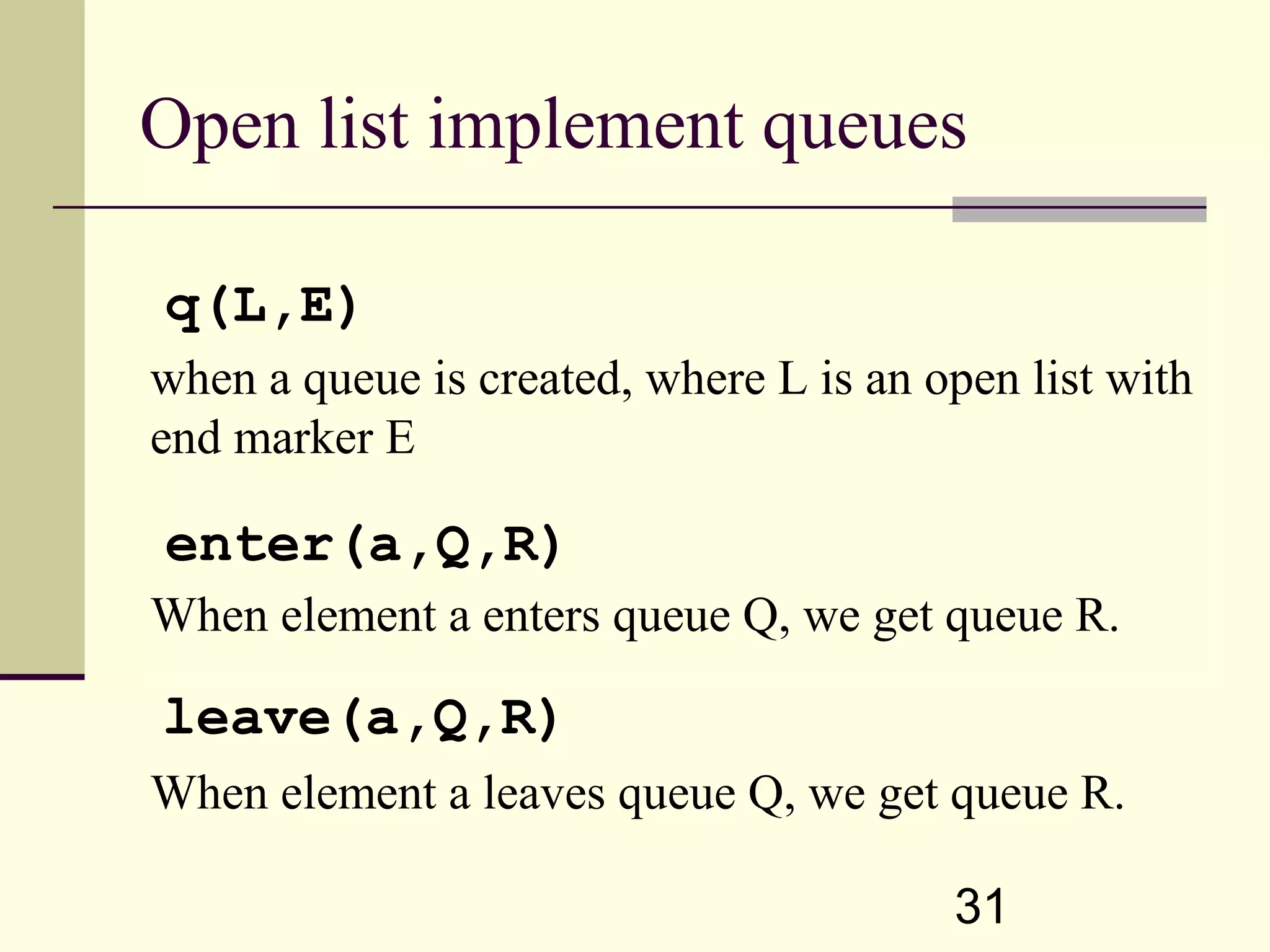
![32 Open list implement queue ?- setup(Q). ?- setup(Q), enter(a,Q,R). ?- setup(Q), enter(a,Q,R), leave(S,R,T). ?- setup(Q), enter(a,Q,R), enter(b,R,S), leave(X,S,T),leave(Y,T,U), wrapup(q([],[])). setup(q(X,X)). enter(A, q(X,Y), q(X,Z)) :- Y = [A | Z]. leave(A, q(X,Z), q(Y,Z)) :- Y = [A | Y]. wrapup(q([],[])).](https://image.slidesharecdn.com/kcq6diylrzcefqezimhz-signature-a2aefd15529654f3e87e362a46d23579b835dc4f23157856393aba9ec132c113-poli-160425153457/75/Prolog-programming-32-2048.jpg)
![33 Test queue ?-setup(Q),enter(a,Q,R),enter(b,R,S),leave(X,S,T), leave(Y,T,U),wrapup(U). Q = q([a, b], [a, b]) R = q([a, b], [b]) S = q([a, b], []) X = a T = q([b], []) Y = b U = q([], []) Yes ?-](https://image.slidesharecdn.com/kcq6diylrzcefqezimhz-signature-a2aefd15529654f3e87e362a46d23579b835dc4f23157856393aba9ec132c113-poli-160425153457/75/Prolog-programming-33-2048.jpg)
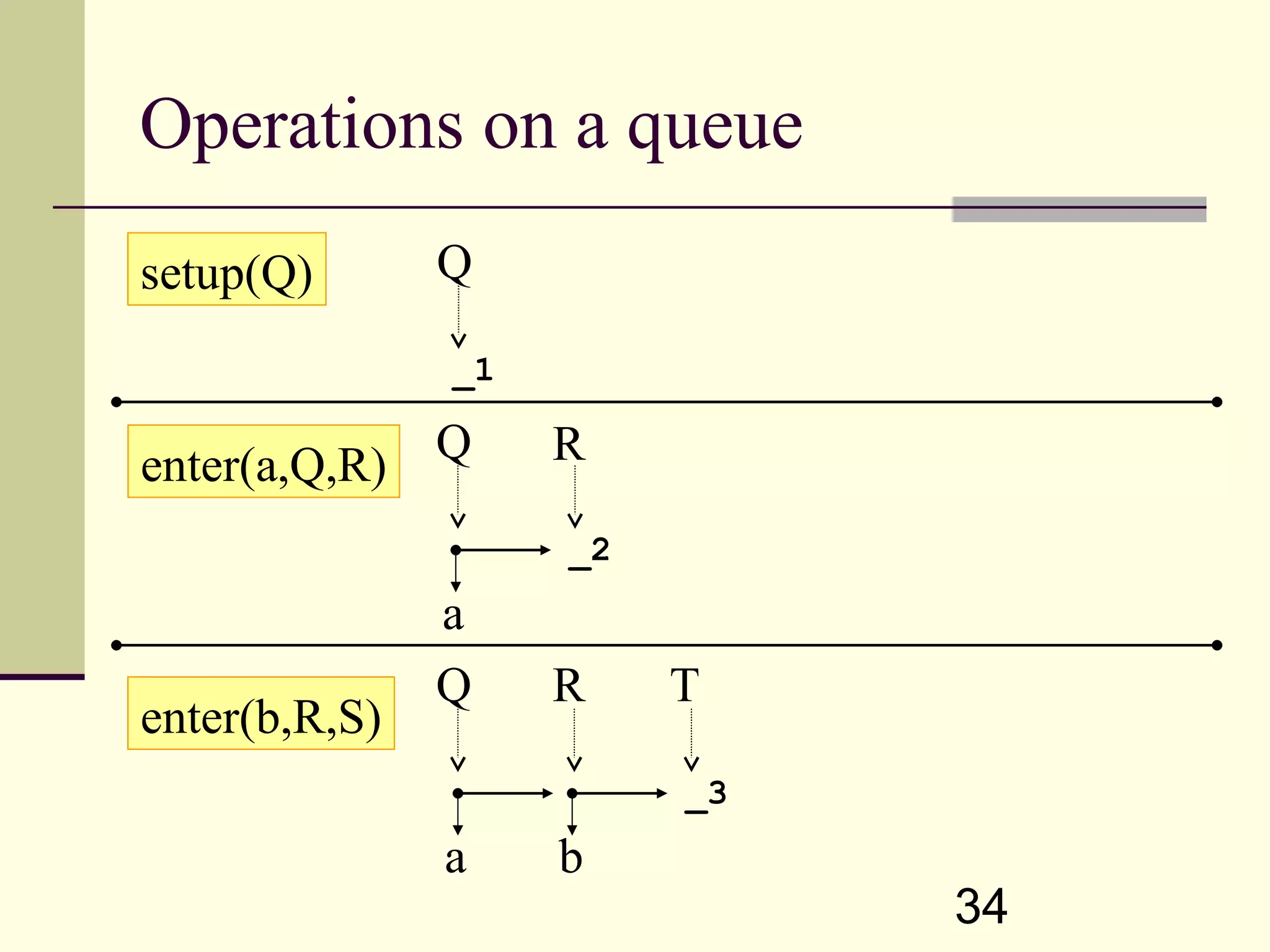
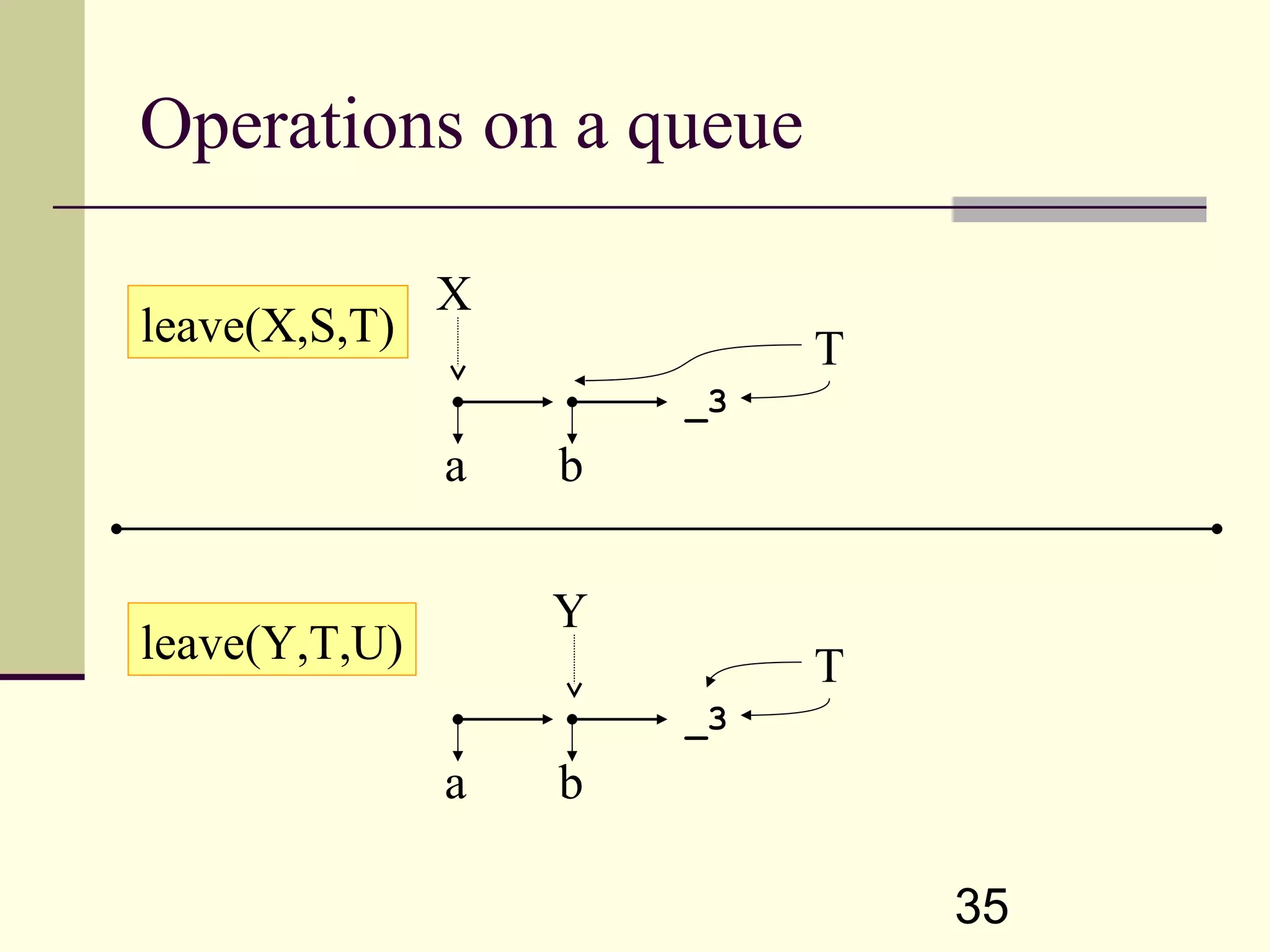
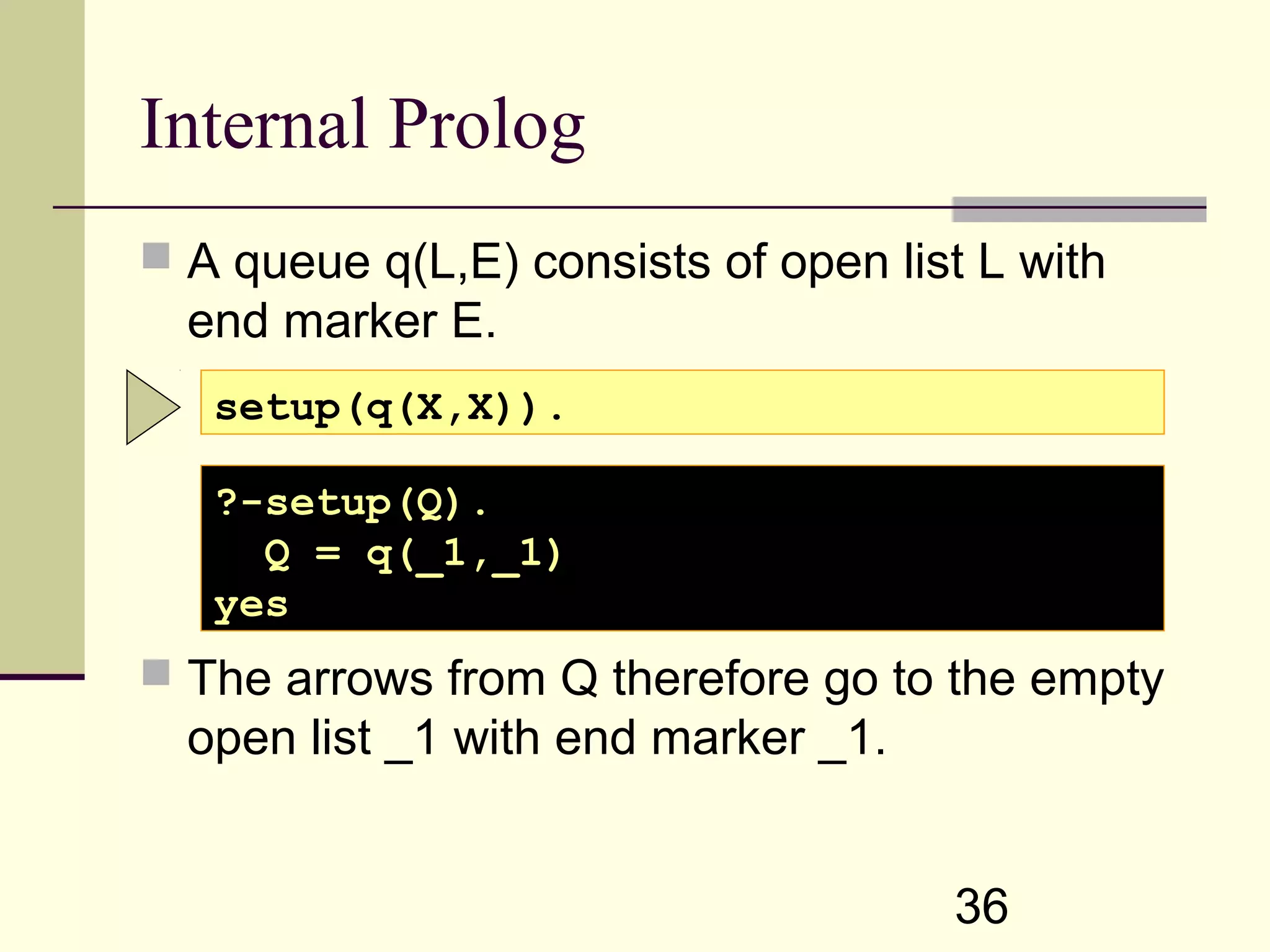
![37 Second goal To enter A into a queue q(X,Y), bind Y to a list [A|Z], where Z is a fresh end marker, and return q(X,Z). enter(A,q(X,Y),q(X,Z)):- Y = [A|Z]. ?-setup(Q),enter(a,Q,R). Q = q([a|_2], [a|_2]) R = q([a|_2], _2) Unifies _1 with [a|_2],where _2 is a fresh end marker](https://image.slidesharecdn.com/kcq6diylrzcefqezimhz-signature-a2aefd15529654f3e87e362a46d23579b835dc4f23157856393aba9ec132c113-poli-160425153457/75/Prolog-programming-37-2048.jpg)
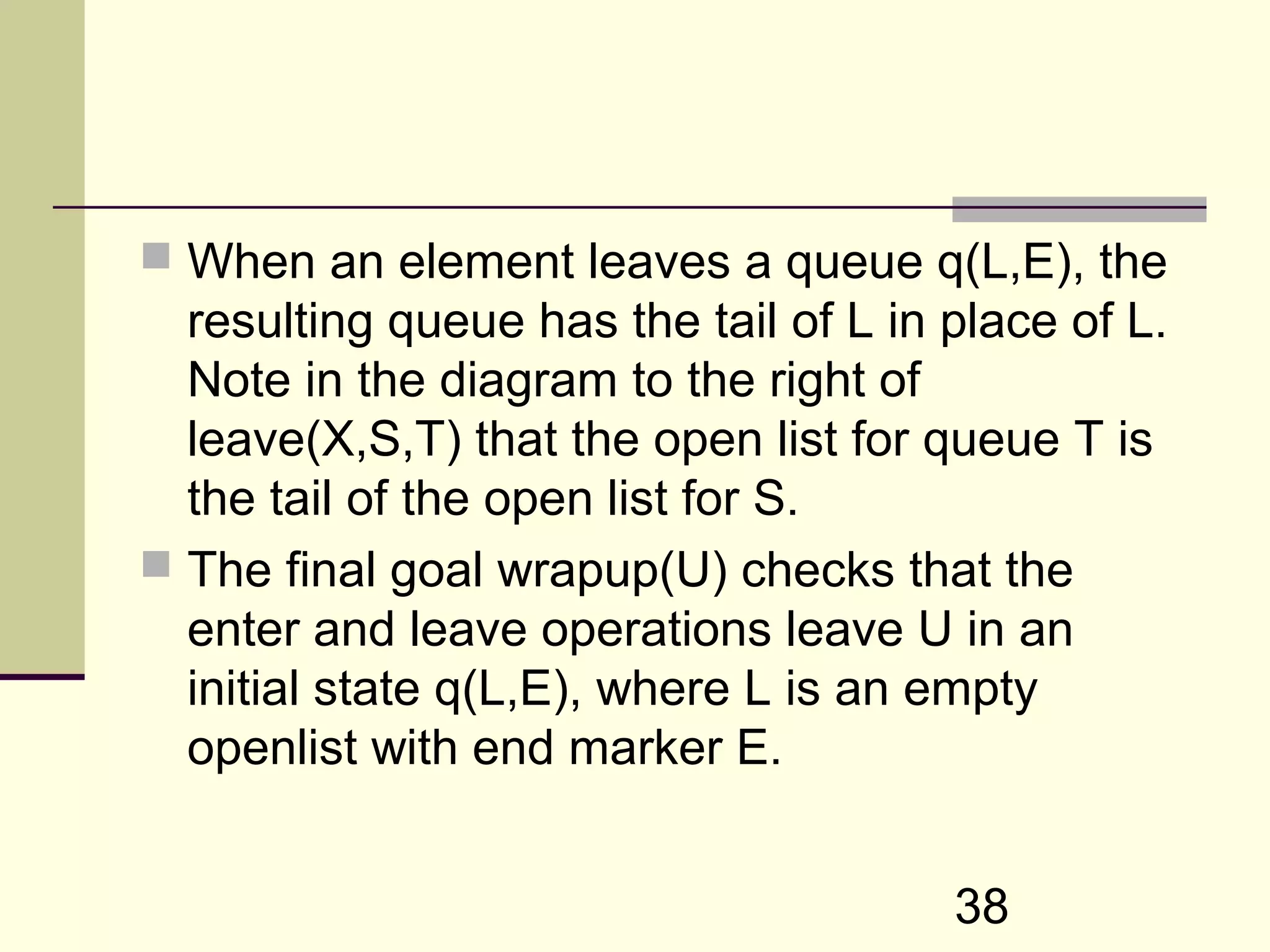
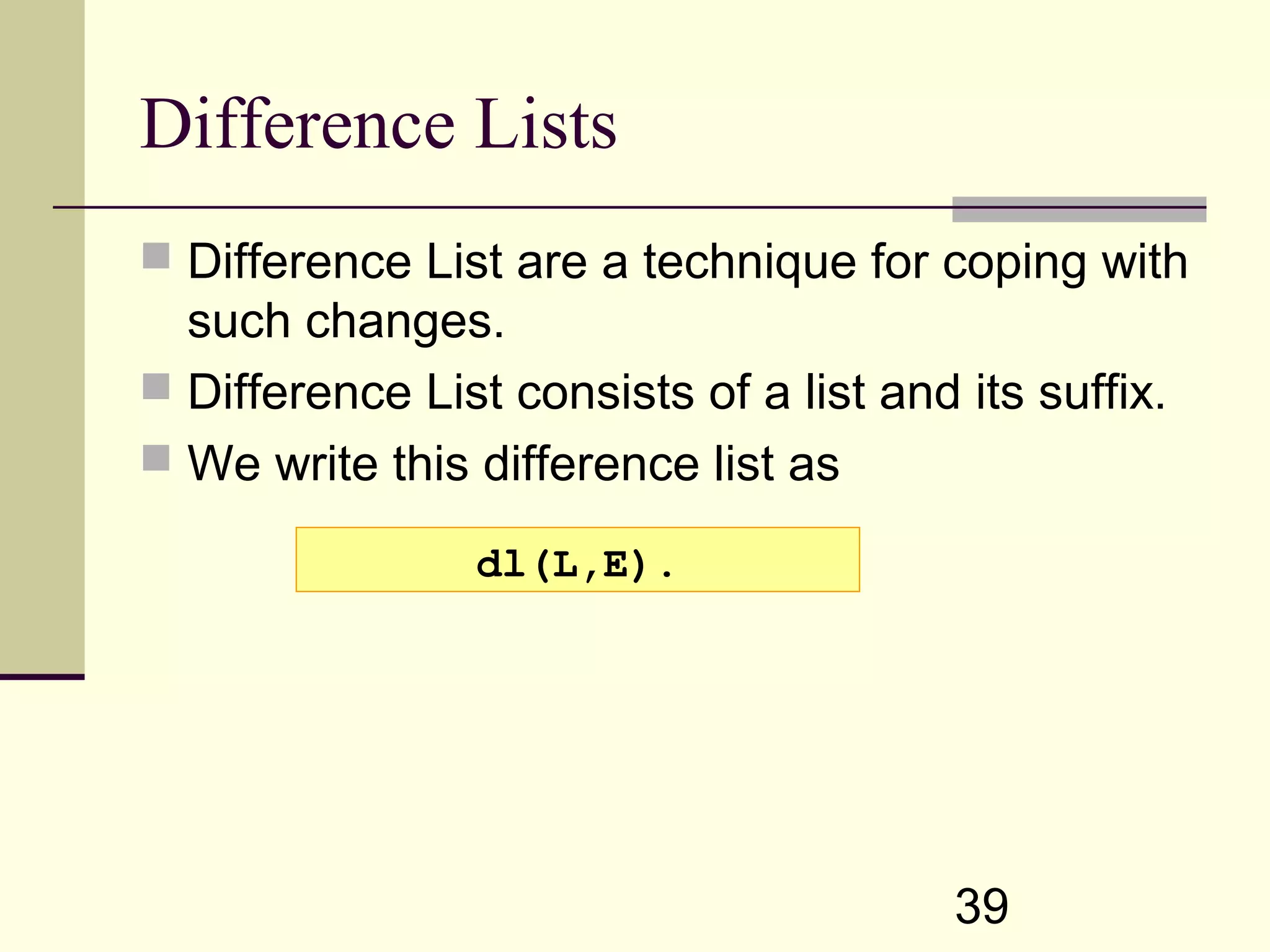
![40 Contents of Difference List The contents of the difference list consist of the elements that are in L but not in E. Examples of difference lists with contents [a,b] are dl([a,b],[]). Dl([a,b,c],[c]). Dl([a,b|E],E). Dl([a,b,c|F],[c|F]).](https://image.slidesharecdn.com/kcq6diylrzcefqezimhz-signature-a2aefd15529654f3e87e362a46d23579b835dc4f23157856393aba9ec132c113-poli-160425153457/75/Prolog-programming-40-2048.jpg)
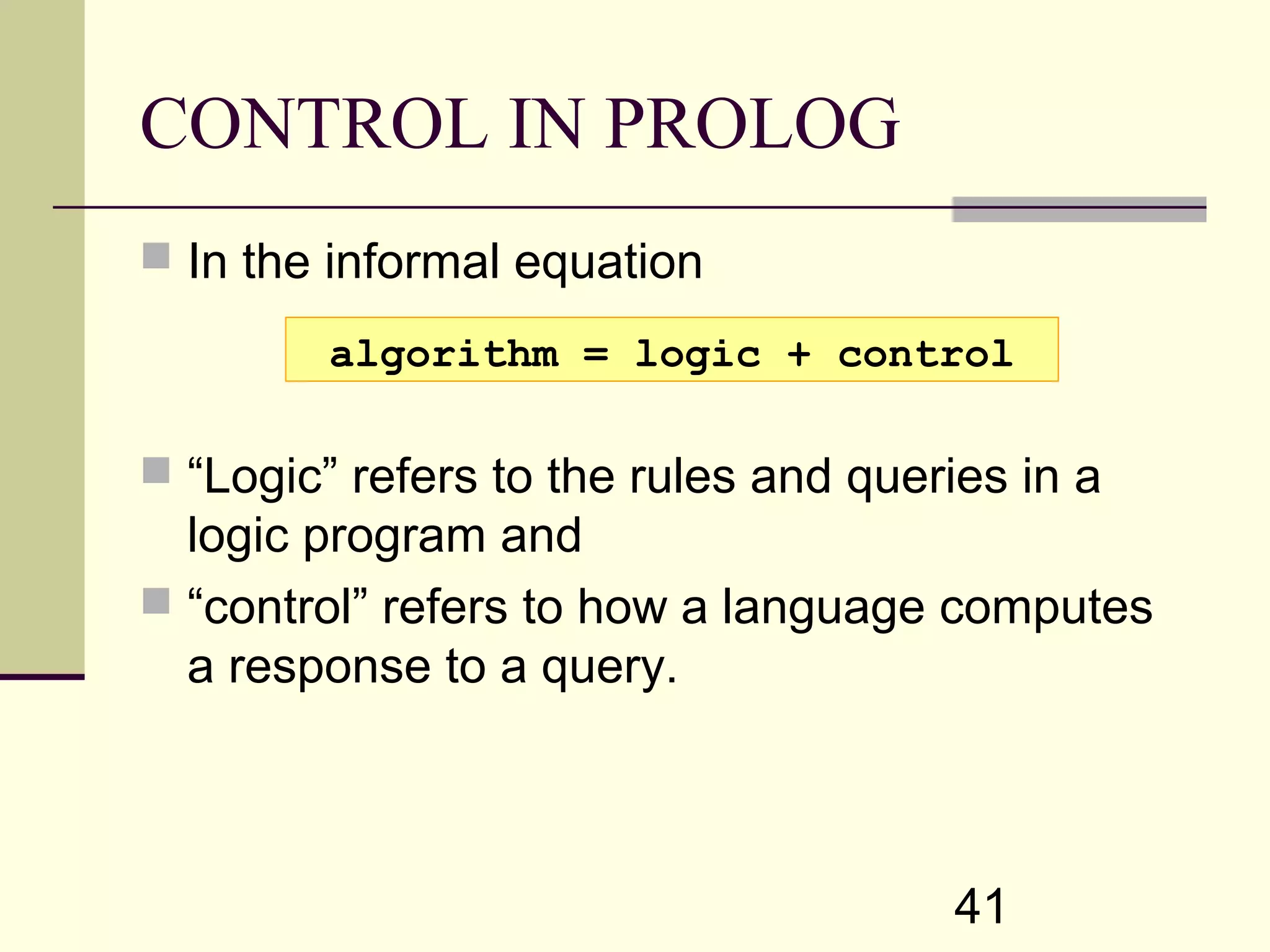
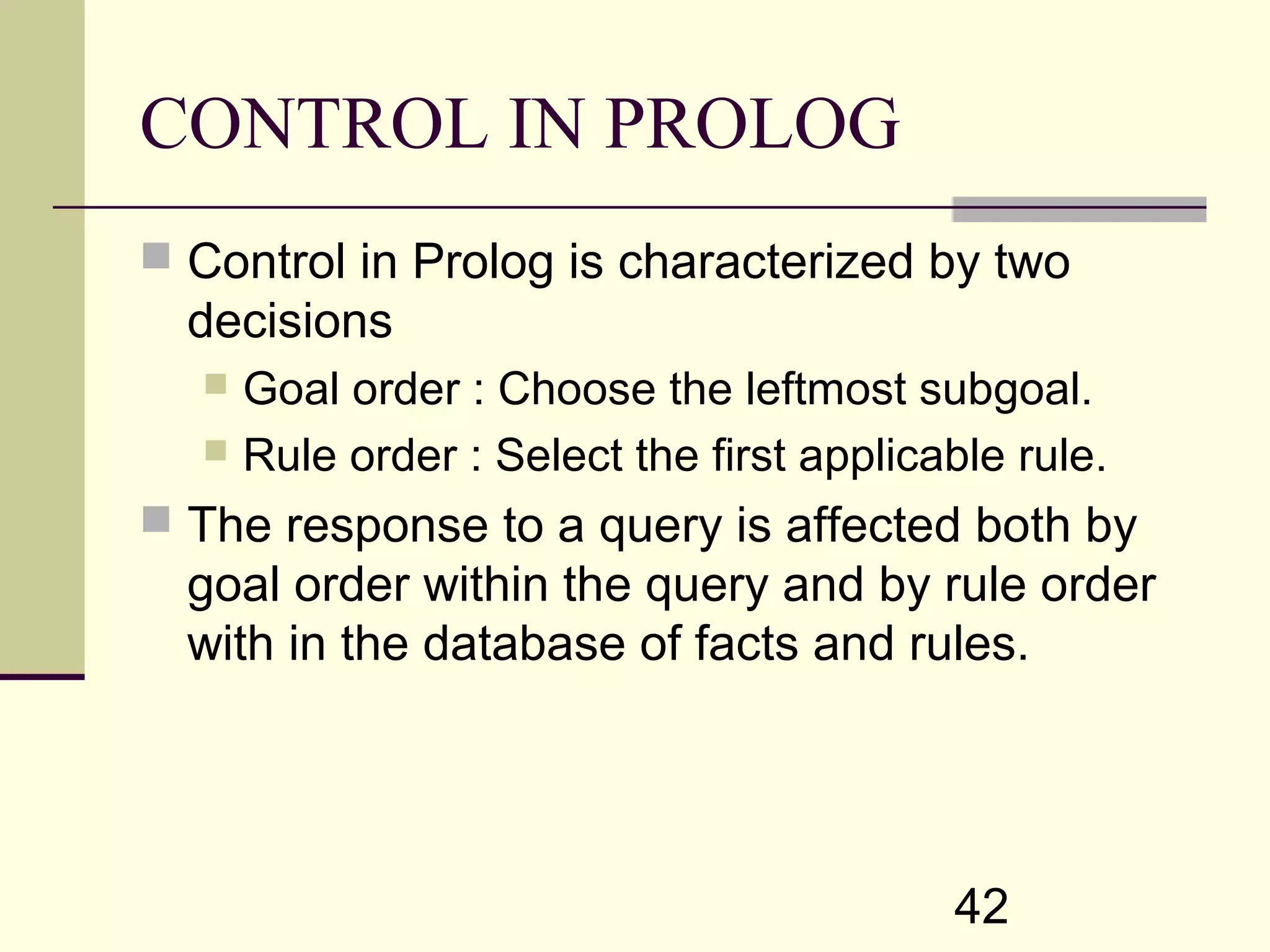

![44 Example A sublist S of Z can be specified in the following seemingly equivalent ways: preffix X of Z and suffix S of X. suffix S of X and prefix X of Z. appen1([],Y,Y). appen1([H|X],Y,[H|Z]):- appen1(X,Y,Z). Prefix(X,Z) :- appen1(X,Y,Z). Suffix(Y,Z) :- appen1(X,Y,Z). appen2([H|X],Y,[H|Z]):- appen2(X,Y,Z). appen2([],Y,Y).](https://image.slidesharecdn.com/kcq6diylrzcefqezimhz-signature-a2aefd15529654f3e87e362a46d23579b835dc4f23157856393aba9ec132c113-poli-160425153457/75/Prolog-programming-44-2048.jpg)
![45 Queries The corresponding queries usually produce the same responses. Rule order can also make a difference. ?-prefix(X,[a,b,c]),suffix([e],X). no ?-suffix([e],X),prefix(X,[a,b,c]). [infinite computation]](https://image.slidesharecdn.com/kcq6diylrzcefqezimhz-signature-a2aefd15529654f3e87e362a46d23579b835dc4f23157856393aba9ec132c113-poli-160425153457/75/Prolog-programming-45-2048.jpg)
![46 Queries ?- appen1(X,[c],Z). X = [] Z = [c] ; X = [_G230] Z = [_G230, c] ; X = [_G230, _G236] Z = [_G230, _G236, c] ; ?- appen2(X,[c],Z). New Solutions are produced on demand for](https://image.slidesharecdn.com/kcq6diylrzcefqezimhz-signature-a2aefd15529654f3e87e362a46d23579b835dc4f23157856393aba9ec132c113-poli-160425153457/75/Prolog-programming-46-2048.jpg)
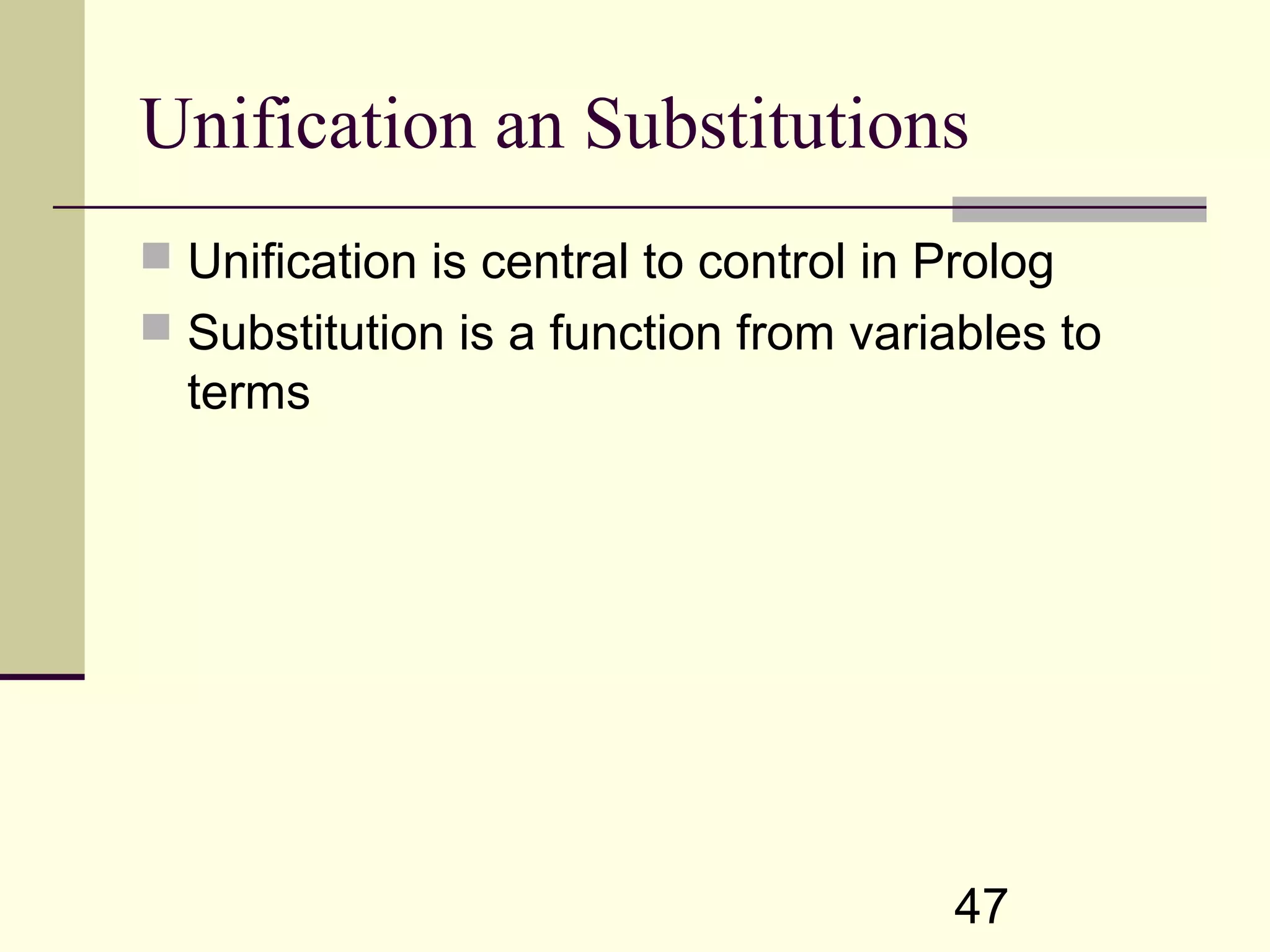

![49 A computation that succeeds without backtracking GOAL Suffix([a],L),prefix(L,[a,b,c]). suffix([a],L) if append(_1,[a],L). Append(_1,[a],L),prefix(L,[a,b,c]). {_1[],L[a]} append([],[a],[a]). Prefix([a],[a,b,c]). prefix([a],[a,b,c]) if append([a],_2,[a,b,c]) append([a],_2,[a,b,c]). prefix([a],[a,b,c]) if append([],_2,[b,c]) Append([],_2,[b,c]). {_2[b,c]} append([],[b,c],[b,c]) yes](https://image.slidesharecdn.com/kcq6diylrzcefqezimhz-signature-a2aefd15529654f3e87e362a46d23579b835dc4f23157856393aba9ec132c113-poli-160425153457/75/Prolog-programming-49-2048.jpg)


